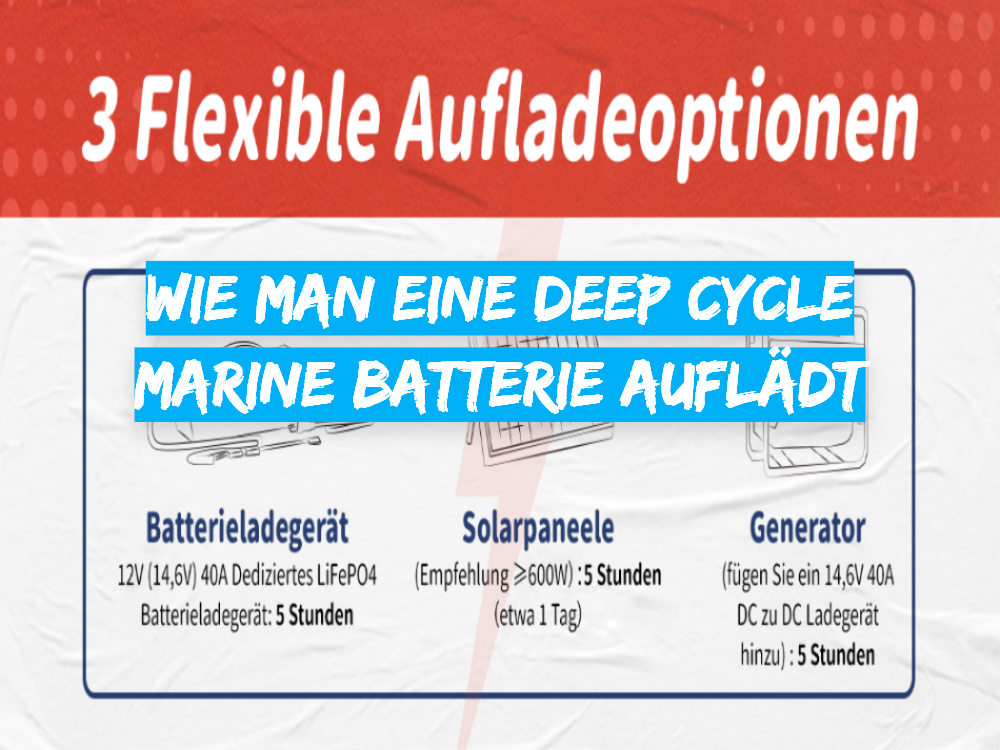[Latest] A Complete Comparison Between LiFePO4 Battery And Lead Acid Battery
![[Neuest] Ein Vollständiger Vergleich Zwischen LiFePO4 Batterie Und Blei-Säure-Batterie](http://timeusbpower.de/cdn/shop/articles/Timeusb_LiFePO4_Akku_12V_200Ah_Plus.png?v=1711423201&width=1600)
In recent years, lithium iron phosphate batteries (LiFePO4 batteries) have gained popularity in the market as a more efficient and environmentally friendly alternative to traditional lead-acid batteries. While lead-acid batteries were the predominant source of energy for many years, the emergence of lithium iron phosphate technology offers consumers the opportunity to make a more informed decision about which battery best suits their needs.
In this article, we explore the differences between lithium iron phosphate batteries and lead-acid batteries and why you should consider switching.
Part 1. Everything you should know about lead-acid batteries
1.1 What is a lead-acid battery?
A lead-acid battery is a rechargeable battery type commonly used for automotive and other applications such as backup power, emergency lighting, and solar power systems. It was invented by Gaston Planté in 1859 and is still widely used today due to its low cost, high reliability and relatively high energy density.
The basic structure of a lead-acid battery consists of lead plates (positive and negative) that are immersed in an electrolyte solution made of sulfuric acid and water. The positive plate is coated with lead dioxide while the negative plate is made of pure lead. The plates are separated by a porous insulator and the entire assembly is housed in a plastic or rubber housing.

1.2 Features of lead-acid battery
- High Energy Density: Lead-acid batteries have a high energy density, meaning they have a high energy density in relation to their weight and volume can store large amounts of energy.
- Low Cost: Lead-acid batteries are relatively inexpensive to produce and widely available, making them an attractive option for many applications .
- Heavy and Bulky: Lead-acid batteries are relatively heavy and bulky compared to other battery types, making them difficult to transport and store can make it difficult.
- Limited Cycle Life: Lead-acid batteries have a limited number of charge and discharge cycles before they begin to deteriorate, which may limit their usefulness in certain applications.
- Toxic Chemicals: Lead-acid batteries contain toxic chemicals such as sulfuric acid and lead, which can be harmful to the environment if disposed of improperly .
Part 2. Why is a lithium iron phosphate battery a better choice?
2.1 What is a lithium iron phosphate battery (LiFePO4 battery?
Lithium iron phosphate batteries (LiFePO4) are a newer type of rechargeable battery that offers several advantages over lead-acid batteries. First of all, lithium iron phosphate batteries have a higher energy density, meaning they can store more energy in a smaller space. This makes them ideal for use in portable devices such as laptops, smartphones and electric vehicles.
2.2 Features of Lithium Iron Phosphate Battery (LiFePO4)
Lithium iron phosphate batteries (LiFePO4) are rechargeable battery types that offer several advantages over other lithium-ion batteries. Here are some of the features of LiFePO4 batteries:
- Higher energy density: LiFePO4 batteries have high energy density, meaning they can store a large amount of energy with a relatively small size and weight.
- Long lifespan:LiFePO4 batteries have a long lifespan, meaning they can be charged and discharged many times without significant loss of capacity
- Safe Chemistry:LiFePO4 batteries have safer chemistry than other lithium-ion batteries because they are less prone to thermal runaway, which can lead to explosions or fires.
- Wide temperature range: LiFePO4 batteries can operate over a wide temperature range, making them suitable for use in extreme temperatures

LFP example products:
LFP-100: Timeusb 12V 100Ah Pro LiFePO4 battery
LFP-50: Timeusb 12V 50Ah Pro Lithium Battery
- Fast Charging: LiFePO4 batteries can be charged at a higher rate than other lithium-ion batteries, allowing for faster charging times.
- Low self-discharge rate: LiFePO4 batteries have a low self-discharge rate, meaning they can retain their charge for a long period of time when not in use.

- Environmentally friendly: LiFePO4 batteries are environmentally friendly as they do not contain toxic metals such as lead or cadmium.
These properties make LiFePO4 batteries suitable for a variety of applications, including electric vehicles, renewable energy systems, backup power systems, and portable electronics.
Part 3. The comparison between LiFePO4 battery and lead-acid battery
|
Battery type |
Lithium iron phosphate (LiFePO4) |
Lead acid |
|
Energy discharge rate |
80%-90% |
30%-40% |
|
Lifespan |
2000 (up to 10 years or longer) |
400 (usually between 3 and 5 years) |
|
Energy density |
High |
Media |
|
Security |
Low (presence of toxic substances) |
Excellent (no risk of fire/explosion) |
|
Charging |
Can be charged much faster compared to lead-acid batteries. LiFePO4 batteries can be charged at high speeds without damaging the batteries. |
To avoid damage, a slower charging speed is required. |
From the format, we can see that lithium iron phosphate batteries have a longer lifespan. The design of lithium iron phosphate batteries indicates that they have a longer lifespan than lead-acid batteries, which typically last 3-5 years. With proper maintenance, lithium iron phosphate batteries can last up to 10 years, resulting in lower replacement costs and making them a cost-effective option.
In addition to their longer lifespan, lithium iron phosphate batteries are more environmentally friendly than lead-acid batteries. Lead-acid batteries contain hazardous substances such as lead and sulfuric acid, which can be harmful to the environment if disposed of improperly. In contrast, lithium iron phosphate batteries are made of non-toxic materials that can be recycled, reducing their environmental impact.
In terms of performance, lithium iron phosphate batteries outperform lead-acid batteries. They can deliver more power in less time, making them perfect for high power consumption applications such as electric vehicles. In addition, they store and release energy more efficiently, allowing devices such as laptops and smartphones to run longer.
Even though the initial price of LiFePO4 batteries is high, let's see what would happen years later.
|
- |
Lead-acid battery (Nominal capacity) |
LiFePO4 battery (Nominal capacity) |
LiFePO4 battery (High Capacity) |
|||
|
Battery capacity |
(Ah) |
400Ah |
||||
|
Lifespan |
Number of cycles with 80% discharge |
500 times |
6000 times |
6000 times |
||
|
- |
Total capacity in 10 years (Ah) |
35200Ah |
700000Ah |
1400000Ah |
||
|
- |
Cycle life (year) |
3 years |
10 years |
10 years |
||
|
Costs |
Selling price (excluding VAT) |
€7.860.93 |
€529.99 |
€1.139.99 |
||
|
- |
the cost in one year (after 5 years of use) |
€1.572.19 |
€180.20 |
€285.00 |
||
|
- |
Cost reduction rate |
- |
66% decrease |
Reduce 75% |
||
|
- |
Water operations and management |
NEED |
NOT
|
NOT
|
Now we can easily see that LiFePO4 batteries are actually cheaper than lead-acid batteries from a long-term perspective. With better performance, it is actually a better choice.
Frequently asked questions about LiFePO4 and lead-acid batteries
1. Can I charge a LiFePO4 battery with a normal charger?
Yes, you can charge them with any type of charger as long as the charging voltage for our 12V series is 14V to 14.6V.
2. Can LiFePO4 battery be charged at low temperatures?
It is not recommended to charge a lithium battery at temperatures below 0°C unless equipped with a balance charger designed for this purpose. Charging a lithium battery at such low temperatures can cause damage to the battery and shorten its overall lifespan.
3. How long do lead-acid batteries last without recharging?
A lead-acid battery can power a device for a single eight-hour shift before it needs to be recharged and cooled down.
Conclusion
While lead-acid batteries have been the preferred energy source for many years, lithium iron phosphate batteries offer several advantages that make them a better choice for many applications. They are more efficient, have a longer lifespan and are more environmentally friendly than lead-acid batteries. If you are looking for a reliable, cost-effective and environmentally friendly battery solution, you should consider switching to lithium iron phosphate batteries.




